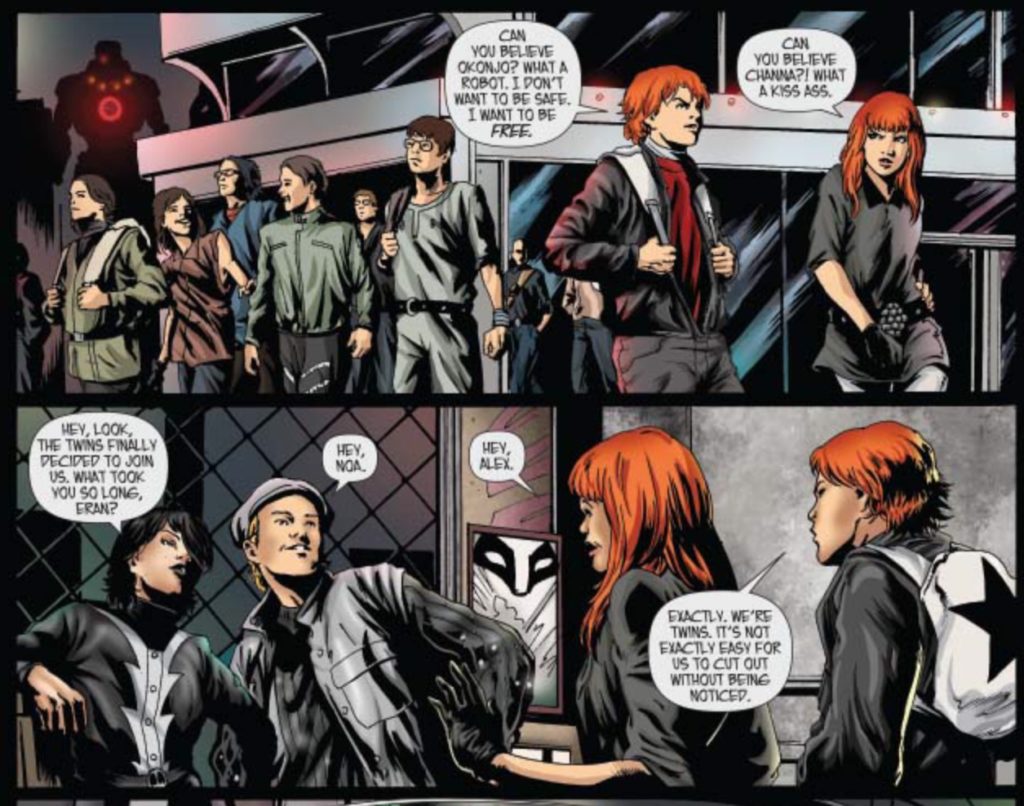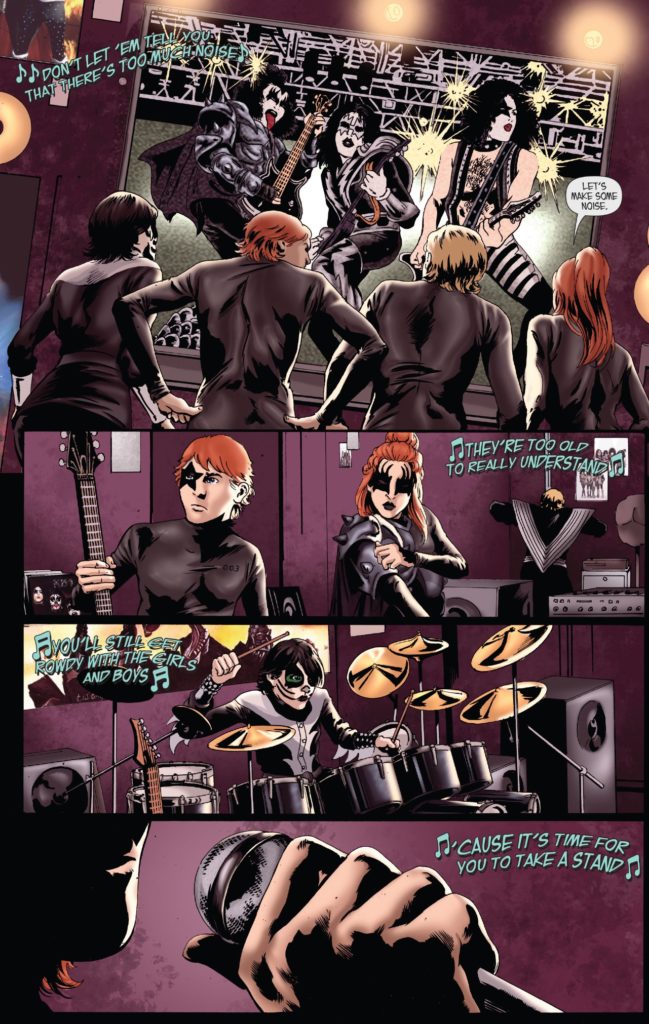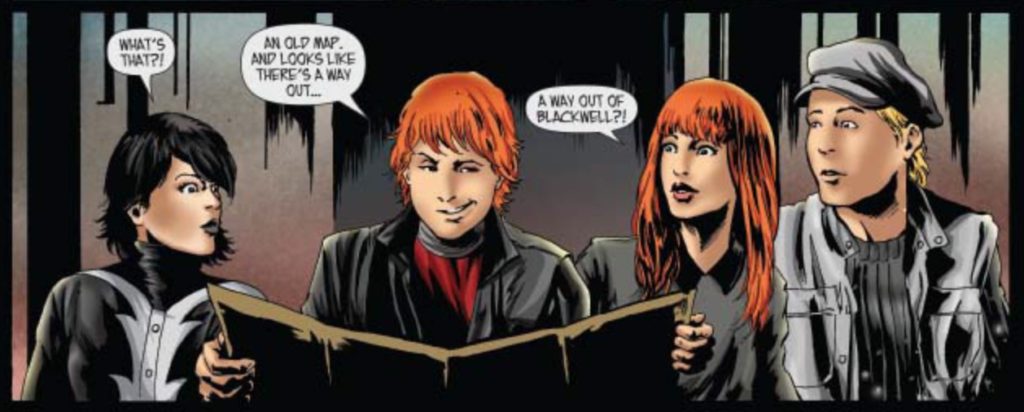I never really needed KISS, but this comic is not just for foot-soldiers in the existing KISS Army. KISS the band can be defined along several lines. They’re a glam rock outfit. They’re a bunch of guys who wear semi-erotic face paint and skintight gear. They’re a #brand. In my entertainment life I already have all of these covered, with change. I have Bowie if I want glam (with lyrics that reach a little higher). I have Misfits if I want spooky lookers (who don’t seem sort of grabby) or a bassist who sings and fronts. And which band isn’t a brand when you grow up with the Spice Girls? If, for some reason, I want a band that sounds like KISS (but with enough sophistication to provoke a sense of ennui), I have Cheap Trick, let’s be real. Look, okay, I don’t think KISS are very good.
But I love KISS, the comic. I love this old-fashioned friendship adventure. I love this comic book about teenaged freedom-seeking and self-removal from the bosom of one’s comfort zone. I love this story where both the boring utopia which our heroines and heroes set out to escape, change and save, and the secret revolutionary forces which empower their self-discovery are heavily indebted to the KISS aesthetic. And you know, I get KISS fandom, even if I don’t go there. As nods and references are woven in to this comic I respect the contextual game as I enjoy the isolated product, no strings attached.
KISS makes KISS an integral visual basic of the world created by Amy Chu (scripts), Kewber Baal (drawing), and Schmerys Baal (colours), an elemental force that stands for fun and boredom, expression and control, truth and lies. Basically, it epitomizes the sum of KISS as it appears to me: the best and worst of Rock’n’Roll. I don’t need to have a pre-existing personal appreciation for the band, the music, the icons, or the lyrics, because they are so present as to be fully explained without any overt definition. Fans will enjoy nods to album covers and cognizable gear, but in KISS, KISS is to be taken for granted. And the presence of this meaningless/meaningful #aesthetic feels so true to the coming-of-age experience. Signifiers are as precious as life or water; exactly what the signify comes second. The mission is: to be.
In issue #1, we learn that four teenagers with (some) attitude are bored of the way things are. How are things? Eran, Noa, Alexm and Adi live in Blackwell, an enclave named for the savior who founded it three hundred years ago. Blackwell was a really big fan of KISS, and it shows in the design principles of his descendants’ society. KISS themselves are forgotten legends, visible at first only by derivation. KISS-brand mech police turned teen-guardian companions? Yes. ???????? (Blackwell’s fandom and the founding of Blackwell are explored in the spinoff title KISS: The Demon, on which Chu shares scripting duties with Eric Burnham. It’s not a necessary companion read, but for the curious, it’s out there.)
Don't forget the creative team are KISS fans- @kewberbaal and letterer Troy Peteri put easter eggs in every issue, so go back and read them!
— ❤️A M Y C H U❤️ #donutkiller (@AmyChu) August 2, 2017
Like its fashion-world counterpart leopard print, within these KISS comics “KISS” is an aesthetic neutral. Much like leopard KISS goes great with red. Red-headed twins, and their best friends.
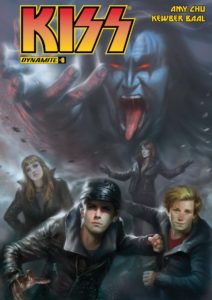
The best friends are, male to female, 1) why I picked up the book in the first place and 2) easily my favorite character. Look at that cutie in his hat to the right; look at how he’s clearly wearing fashion. Any boy who wears a hat is making a sartorial choice; any boy who matches his hat to his jacket in a Marlon Brando mold is clearly, in comic book terms, being presented. He’s front and center on that cover; he’s being shown. I am being shown a young hunk who makes purposeful style choices (secondarily: ones I enjoy), therefore I feel safe and welcomed as a reader. It’s really simple. If boys are making overt fashion choices on covers, the narrative voice seems less likely to–or at least patently has no leg to stand on, should it–denigrate girls who do the same (i.e. me, my past self, my peers). This is the maths of my potential readership. To skate near the edge of the metaphoric abyss, the maths of my ongoing readership look something like this: earnest emotion + unselfconscious flamboyance + boisterous friendship dynamics = buy it. Or, challenging girl + subdued appearance + capacity for unselfconscious joy = I love her, I’m so glad I bought this!
 I began this love song when only six issues were published; I’m finishing it now as the tenth and final release hits. I’ve taken my time because I love it so much. I have a really pure eyes-to-nerves enjoyment of these comics, a wholesome-feeling pleasure that manifested in the full, entire tear that ran down my face as I read issue nine. I wasn’t crying because something sad happened or because the text expected me to at all. I was just really happy, because the comic was so nice. Honesty demands that I acknowledge that there is no queer content in this book, at least before I read issue ten. You might not love it like I do. I can tell that I love it so particularly because it’s temperament is familiar; KISS is like the best comics I read when I was small. This KISS comic is like the best of Bunty.
I began this love song when only six issues were published; I’m finishing it now as the tenth and final release hits. I’ve taken my time because I love it so much. I have a really pure eyes-to-nerves enjoyment of these comics, a wholesome-feeling pleasure that manifested in the full, entire tear that ran down my face as I read issue nine. I wasn’t crying because something sad happened or because the text expected me to at all. I was just really happy, because the comic was so nice. Honesty demands that I acknowledge that there is no queer content in this book, at least before I read issue ten. You might not love it like I do. I can tell that I love it so particularly because it’s temperament is familiar; KISS is like the best comics I read when I was small. This KISS comic is like the best of Bunty.
Bunty was a girls’ weekly comic from 1958 until it floundered around the turn of the century. It was the first “big girls'” magazine I took, and it’s a product I still collect today. Bunty ran comic stories of several genres, but all of them really were adventure comics. A girl with a job–has an adventure! A girl at school–has an adventure! A girl in a skill-based club–has an adventure! A dog who lives with a family battling class issues…has an adventure. Bunty stories largely took place in place their present day, but it wasn’t uncommon for them to take place in the future, or a near-future–science fiction was definitely a part of their ouvre, if it didn’t comprise the meat and potatoes. In Bunty stories people’s family members died and were injured, stray children became endangered or needed harsh lessons, girls faced grim dangers, both mystery and athletics-based, with only the twin powers of pluck and friendship to keep them going. Aspirational creativity was big, as well as community formation. Principles were adhered to. Girls made mistakes, and paid for them, with firm chins and wobbling lips. All of this is what I see in KISS.
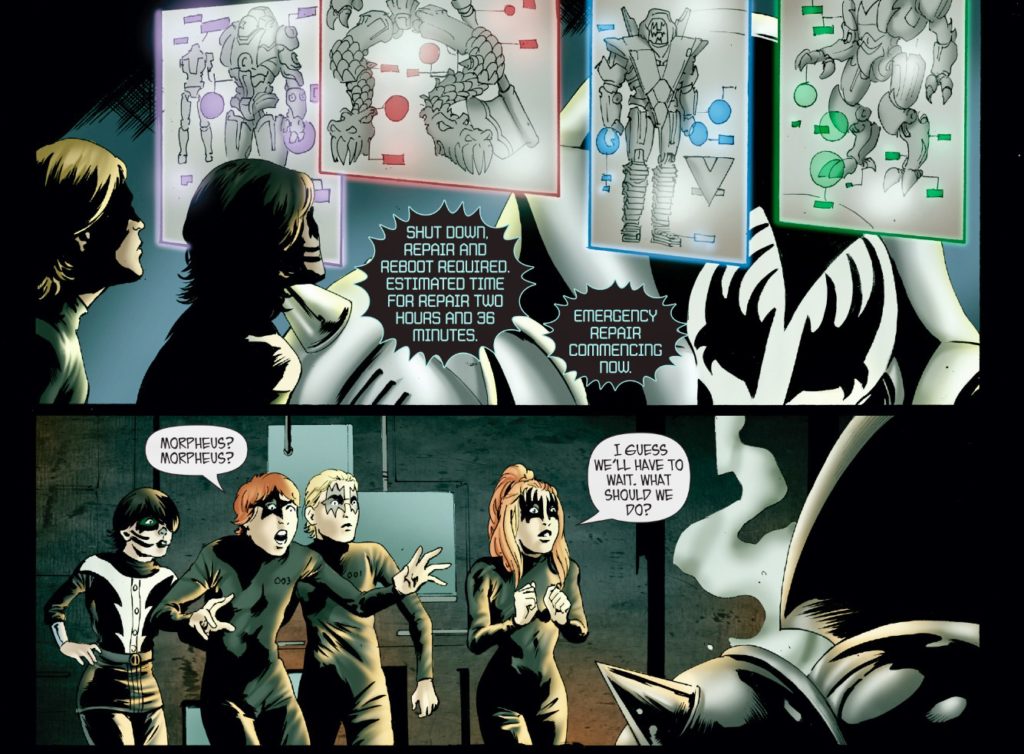
The story evolves so fast and with such a serial nature–this is great monthly comic writing–that to firmly state a premise would be misleading. At first it’s about this, then this turns out to be that, then that perhaps wasn’t quite what it seemed. In issue #9 two groups of girls play rock music in turn as their only mutually understood language, as both turn out to be ambassadors for their respective factions of space-tossed castaways. The group of human survivors we meet in issue #1 is not the last strain of humanity…America is not the last gasp of this world. KISS the comic supposes about the legacy of a billionaire industrialist KISS fan as the leader (the backer) of an apocalyptic survivalist isolation experiment. The teenagers we follow have lived their entire lives in his emergency technoasis, three hundred years later. Who would be in there? Would there truly be one solo savior of our species? The initial cast appear “unmarked,” they are the commonly expectable white protagonists, but the way the modular story is designed (which thematically agrees with the fledgling nature of the very sheltered teenaged characters) denies reliance on white supremacy, even if happenstance (or the other thing) provides a white majority. Issue after issue, Chu’s scripts push forward, stride deeper, crash all of her toys together to make sparks fly, and do it with the sort of excited warmth that lets a skinny teen boy in Star Child makeup and leather cry running tears because what he hears in his headphones just make him feel…so much…!
…Without it being a joke, and without subsequent emotional take-backs, and with his girlfriend and sister and friend seeing nothing strange in it at all. Melodrama is normalised in a really gorgeous way, in KISS. In fact it’s half Bunty, half Rock & Rule, with the feelings music engenders being transmuted into personal energy. These children tap the ~power of rock (I can’t even type that straight-faced, but the comic makes it happen) to form unlikely bridges and let nobodies do something for their world. It’s so innocent! The book is full of action and doom and death, but it’s so non-violent, so hate free.
KISS is non-ironic, but it’s awake to the fact that it could be. Amy Chu is no fool. She gives her Gothy, wry girl sweet unhindered joy at seeing a tree for the first time in her life on purpose, she lets her characters bond by garage-banding KISS (so bad, reader) lyrics on the floor on purpose, she turns the idea of the KISS Army into a Dumbledore’s Army on purpose. She is making the choice not to blink. Yeah, we could do it for lols. KISS comics, amirite? But if we did it with feeling, wouldn’t that be better? Doesn’t it feel good to be carefree about being earnest? Yes. Yes! Under their make-up masks, Chu and Baal give their would-be runaways all the wide-eyed and good-hearted naïveté of Ted “Theodore” Logan to whom God herself gave Rock’n’Roll. And yea–I see that it is good.
Bonus tracks:
- Noa wears the Demon (not one of the boys)
- The Fox makes an appearance later (Ankh Warrior thus-far unseen–I don’t dig KISS but I do my research)
- Japanese dialogue is genuine and untranslated
- There’s kissing! But no Simmons tongues. Rated Teen!
Diss track:
- Troy Peteri, letterer, really needs to double check his work. It’s attractive and aesthetically well-placed but typos are regular and speech bubbles occasionally, but notably miss-attributed. Oi, editor!


